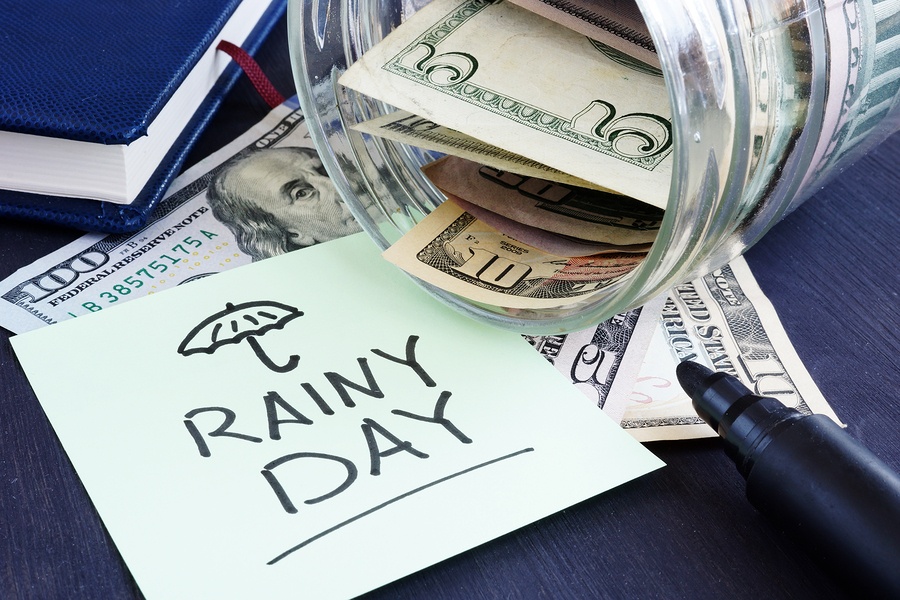One of the most common questions we get from clients is how to handle an emergency reserve. If clients have an emergency reserve, questions typically center around how much they need and how it should be invested. If they don’t have an emergency reserve, the first question is how to establish a reserve while they’re saving for retirement or some other financial goal, and also about how much they should set aside. Given the ongoing Federal Government shutdown, I thought it would be useful to revisit the idea of reserves.
In the budgeting system I use, there are a couple of different categories of reserves. The first type of reserve is the emergency reserve, and it is used when income decreases such that you can no longer cover your expenses1. The general rule of thumb is that an emergency fund should cover 3 to 6 months worth of expenses, and the more stable your income, the less you need in emergency reserve.
I think the rule of thumb is a useful starting point, but you should really consider your specific situation. If you’re married and both you and your spouse are tenured faculty, you might be okay with less than 3 months worth of emergency reserve if you’ve got a rainy day reserve as I outline below. If on the other hand, you work in the film industry and only get paid when you’re on a project, you might need more than 6 months worth of expenses in reserve if the time between films is really unpredictable. The more stable your income stream, the less you need in an emergency fund.
Beyond an emergency fund to cover loss of income, you should also have some sort of rainy day fund. These funds are used to cover unexpected repair expenses that are usually related to your home, your car or, in the case of an HSA or FSA, healthcare costs. Determining how much you need to fund in these categories can be tricky, but in general, the older a home, car (or, sadly, a person), the higher the repair and maintenance expenses will be.
We own an older home, so I’ve been a bit more aggressive in funding a reserve. The two most significant expenses in the next 10 years will likely be a new roof and a new HVAC, so once the reserve is enough to cover those items, I won’t fund it beyond that. If small items crop up in the meantime, we’ll pay for those from the reserve and replenish until the reserve is back to its maximum level. If you are buying a home, a good home inspection can be extremely helpful in determining what repairs are likely to be needed, and you can use the inspection report to determine how much you’ll need to set aside.
Setting up a reserve for cars is a bit easier, as a number of services (here and here for example) provide an estimate of total cost of ownership. The components you’ll want to focus on are costs for maintenance and repairs. At some point, you’ll need to replace your car, and before that point, ideally, your repair and maintenance reserve will convert to a new car reserve. You’ll need to fund this reserve at a good bit higher rate when this happens, but the advantage of doing this is that you can substantially reduce or eliminate the need for a loan when you buy your next car. As for setting aside a reserve for healthcare, I’ve covered the ins and outs of HSAs here.
Funding a reserve while saving for longer-term financial goals can be a challenge. If you have a budget, you’ll know what your immediate cash needs are, while a financial plan will identify how much you need to save towards larger financial goals. Any cash you have left over after funding the budget and the plan savings could be used to build reserves. If you don’t have any money left over, you have a couple of options as follows:
- Rework your budget to reduce your spending and free up cash.
- Change your plan assumptions so that you can reduce the amount you need to save and allocate the additional cash to your reserves.
- If a portion of your longer-term savings is in a taxable account, that can double as an emergency reserve (though ideally, not as a rainy day reserve since you’ll very likely use that reserve more frequently).
- Check to see if your employer offers short term disability coverage. This won’t help for rainy day expenses and it is only useful in the limited instance of being unable to work due to disability, but it does cover a portion of your potential risk.
Once your reserve is established, don’t chase higher returns. Your reserve is meant to cover emergencies and large, unexpected expenses. You don’t want a situation like that to arise only to find that your reserve isn’t sufficient because it has dropped sharply in value. If you’re particularly concerned about maximizing the return of your entire portfolio – including your reserves – you might consider combining some reserve items to reduce the amount you need to set aside. For example, you might elect not to fully fund the reserve for your house and your emergency reserve because odds that you’ll lose your job and need to replace your roof at the same time are pretty low.
It can take time to build an emergency reserve, but the first step is determining how much you should set aside. Once a reserve is in place, the odds that you’ll run up credit card debt or fall behind on paying your bills drop significantly. It is a good bit of work to determine how much you need to set aside and it can be challenging to find the cash flow to do so, but the long-term benefits of doing so are clear.



